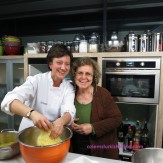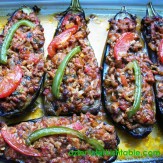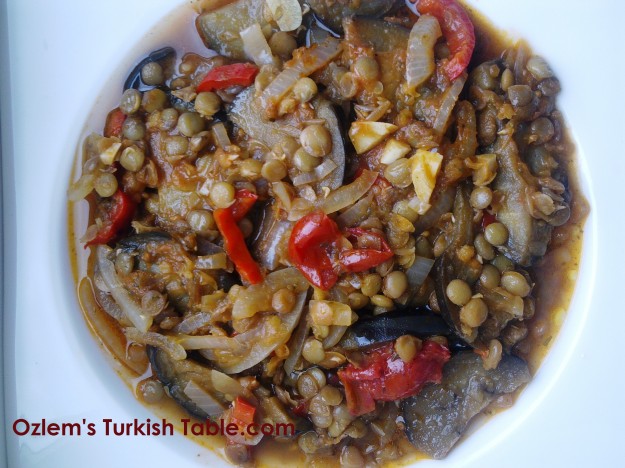 Please click on the image to view my culinary and cultural trip to Turkey photo album for 2009!
Please click on the image to view my culinary and cultural trip to Turkey photo album for 2009!

Cookery Classes

Recipes
Eggplants with Lentils, cooked in Olive Oil; Mercimekli Mualla

Aubergine with green lentils, aubergine onions and peppers; Mercimekli Mualla- such a delicious treat
It is high time for an eggplant (aubergine) recipe, the king of vegetables at home. Eggplant lovers at home claim we have over 200 eggplant, patlican recipes, as we love this special vegetable so much. My name in our home is actually “Patlican” too – or Patli as short-. When my husband heard the name for the first time, he liked the sound of it so much that he decided to call me Patlican! No complaints.
We have a whole section in Turkish cuisine called “Vegetables cooked in Olive Oil”, Zeytinyaglilar, where we cook vegetables in olive oil and serve them either cold or at room temperature. Once cooked, it is important for the dish to cool down in its pan and rest, allowing all the flavors to blend. Usually served with a wedge of lemon, this style of cooking is very healthy, tasty and refreshing.
Here is also my YouTube video on how to make Mercimekli Mualla:

This traditional recipe, Patlicanli Mercimekli Mualla, is from Antakya, Southern part of Turkey, where my roots are from. The amazing flavors of green lentils, olive oil, eggplant and dried mint blend so well and take me back to Antakya immediately. This is a traditional recipe and I am especially happy to be able to pass it on to food lovers and the next generation, and delighted to include at my cookery book, Ozlem’s Turkish Table, Recipes From My Homeland; Signed copies now 25 % off at this link, for a limited time and delivered worldwide, including the US, if you’d like to grab yours. It is a joy to trace these recipes over many phone calls to my mother, passionately exchange opinions on it and finally have a chance to share with you. I hope you enjoy this wonderful dish and pass it on.
Serves 4-6
Preparation time: 25 minutes Cooking time: 40 minutes
180 gr / 1 cup green lentils
2 large or 3 medium eggplants (aubergine)
2 medium onions, thinly sliced – about 1 cup –
4 cloves of garlic, crushed
1 red bell pepper, cut in half and thinly sliced
400 gr / 14 oz (a can of) chopped tomatoes in juice
50 ml/ about 2 fl oz/ 1/4 cup olive oil and
45 ml / 3 tablespoons of olive oil to saute eggplants
1 teaspoon salt
2 teaspoons granulated sugar
1 teaspoon dried mint (spearmint)
240 ml/ 8 lf oz / 1 cup water
Crusty bread to serve
Put lentils in a pan of boiling water, stir and cover. Simmer in low heat for 15 minutes. Drain its water and set aside.
Using a vegetable peeler, peel the eggplants in zebra stripes. Cut the eggplant in half lengthways and then cut each half into medium thick slices (about 1.5cm thick). Spread them on a wide tray, sprinkle salt over and leave aside for 15 minutes. With using paper towel, squeeze excess water out of eggplants.
Heat the olive oil in a large, heavy pan and sauté the eggplant slices over high heat for a minute or two. This will help eggplants to soften up and start bringing out their lovely sweet flesh – if your pan is not large enough, this may take 3-4 minutes-.
In a large bowl, combine the partially cooked lentils, onion, garlic, bell peppers, chopped tomatoes, salt, mint, olive oil and the sugar, mix well. Season with ground black pepper, check the seasoning and add more salt if needed.
In a wide heavy pan, place a layer of the eggplant slices. Spread the half of the vegetable mixture over the eggplants evenly. Place the remaining of the eggplant slices over the top and spread the remaining vegetable mixture over. Add the water, season, cover and cook in medium to low heat for about 40 minutes.
Once cooked, cover and cool the dish in the pan. Serve at room temperature with some crusty bread.
Tips and facts on Eggplant (Aubergine):
1) This wonderful vegetable (actually fruit, as it has seeds) has about 90 % water, which makes it low in fat and calories. You need to get rid of the sour juice of the eggplant before cooking. You can do that by salting the eggplant slices, and squeezing the sour juice out using a paper towel.
2) You can’t eat eggplants raw but once cooked, the flesh becomes meaty and sweet; which makes a great vegetarian option.
3) We Turks love eggplants; we grill it, broil it, bake in the oven, smoke it and even make lovely jams out of it! As nation’s favorite vegetable, it is believed we have over 200 recipes featuring the beloved eggplant, patlican.
4) When shopping for eggplants, look for bright dark purple color and a healthy green stem. It should feel heavy for its size. Try to get a small to medium size eggplants as they tend to have less seeds.
Angus's Spaghetti Shrimp with Turkish Red Pepper Flakes infused Olive Oil – Angus'un Karidesli, Kirmizi Biberli Makarnasi

My husband Angus makes an incredible shrimp spaghetti using Turkish red pepper flakes and he kindly let me share his wonderful and easy to prepare recipe with you. He infuses the smoky Turkish red pepper flakes in olive oil, which adds an amazing flavor to the shrimps. I always, always look forward to his shrimp spaghetti!
If you can’t get hold of Turkish red pepper flakes (preferably Aleppo), substitute with hot chili flakes. Make it as fiery as you like!
Serves 2 generously
Preparation time: 5 minutes
Cooking time: 15 minutes
280 gr / 10 ounce spaghetti
225 gr / 1/2 lb raw king prawns, shelled
4-5 tablespoons olive oil
1 heaped teaspoon of Turkish red pepper flakes
Thinly shaved Pecorino Romano to serve
Cook the spaghetti in plenty of lightly salted boiling water until a minute before it is al dente (please refer to the cooking time on the pasta’s packaging). Drain the water and set aside the pasta in the colander.
Heat the olive oil in the pasta pan on a medium heat and add the red pepper flakes. Stir gently and let the red pepper flakes infuse to the olive oil for about 30 seconds (avoid cooking longer as the red pepper flakes go black and can burn quickly). Add the shrimps and stir fry for about 3 minutes. Turn off the heat, combine the cooked spaghetti with the shrimps and mix well for a minute. Make sure all the spaghetti is well coated with the olive oil infused red pepper flakes and the shrimp.
Transfer the pasta to a warmed serving bowl and serve with shaved Pecorino Romano cheese over the top. A green leafy salad with a simple lemon dressing goes very well with this dish.

